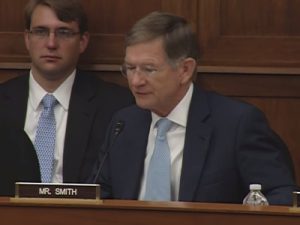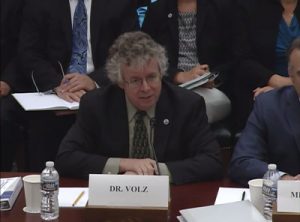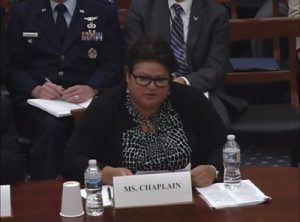On the morning of Thursday, July 7th, the environment subcommittee of the U.S. House Committee on Science, Space, & Technology convened for a hearing titled Examining the Nation’s Current and Next Generation Weather Satellite Programs. The day’s panel included representatives of the National Oceanic and Atmospheric Administration (NOAA), the U.S. Air Force and the U.S. Government Accountability Office (GAO). The day’s discussion mainly focused on the progress of satellite programs being implemented by various government agencies and risks that those programs might face in the future.
The day began with the subcommittee’s chairman, Rep. Jim Bridenstine (R-OK), noting recent failures in weather satellite programs involving American federal agencies. One of these was the National Polar-Orbiting Operational Environmental Satellite System (NPOESS), a satellite system that was supposed to serve the needs of both NOAA and the U.S. Department of Defense (DoD); NASA was a third agency involved and was responsible for assisting in tech acquisitions. When planned, it was designed to fill the needs of three-day to seven-day weather forecasting for both civilians and military personnel. NPOESS was scrapped in 2010 after program delays and rising cost estimates, from $6.5 billion in 2002 for the system’s life cycle up to $13.9 billion in 2010. More stumbling blocks in weather satellite systems were experienced by the Defense Weather Satellite System (DWSS), which was to be the DoD’s portion of what was spun off from NPOESS when its mission objectives were split up after the 2010 decision to end that program. In December 2011, President Barack Obama effectively terminated DWSS by signing an appropriations bill which authorized money for termination liability costs but not continued development of the program.
The Joint Polar Satellite System (JPSS), NOAA’s project after the restructuring of NPOESS, has experienced a better environment. Although the program has also faced some delays, the first satellite in the constellation (JPSS-1) is currently set for a March 2017 launch date. When all four JPSS satellites are launched by the 2030s, the constellation will make global measurements of conditions in the atmosphere, on land and in the oceans.
“NOAA’s weather satellite programs play a critical role in the continued help of our weather forecasting programs,” said Rep. Eddie Bernice Johnson (D-TX), the ranking Democratic member of the House science committee. She and other representatives voiced concerns over a potential gap in weather satellite data caused by a lack of functioning polar-orbiting satellites, which could affect the accuracy of future weather forecasts and speed at which they can be developed. Concerns over such data gaps were increased this March when a primary U.S. Air Force weather satellite known as DMSP-19 experienced a power failure and could not be recovered.
Dr. Stephen Volz, assistant administrator to NOAA’s National Environment Satellite, Data, and Information Service (NESDIS), spoke to a variety of NOAA satellite programs currently underway other than JPSS. One such satellite currently in operation is the Deep Space Climate Observatory (DSCOVR), launched last February primarily to monitor solar winds. Volz also referenced the Geostationary Operational Environmental Satellite-R (GOES-R), a next-generation version of GOES satellites currently in operation which can provide three times more spectral data, four times the spatial coverage and a fivefold increase in temporal resolution than the conventional models. The launch of GOES-R is currently scheduled for November 4th of this year.
Ralph Stoffler, director of weather for the U.S. Air Force, spoke on his agency’s primary mission to forecast global weather which can impact military operations around the world. “We’re capitalizing on weather conditions and maximizing our effectiveness against enemy forces,” Stoffler said. He added that the information and data from weather satellites which is assimilated into data centers is fundamental to strategic needs and is used to provide unified forecasts to military personnel.
David Powner, director of IT management issues at the GAO, and Cristina Chaplain, the GAO’s acquisition and sourcing management director, brought criticisms of the weather satellite programs of both agencies to light. Powner questioned flyout charts developed by NOAA which are meant to reflect the long-term plan regarding the stEeeeeeeorage, launch and operation of a satellite, charts which had changed multiple times in recent years for JPSS satellites. He noted that the launch readiness date of JPSS-1 had recently moved from December 2016 to January 2017. “Rigor in flyout charts is critical to build trust between NOAA and [Congressional] committees,” Powner said.
Chaplain’s comments focused more on the DoD and a lack of rigorous analysis at that agency of its own satellite programs. Chaplain noted the potential for gaps in coverage over the Indian Ocean which could hinder cloud characterization and theater weather imagery. She also found collaboration between NOAA and the DoD to be ineffective, resulting in poor planning in addressing potential future data gaps. “The longer it takes to figure out a path, the longer the DoD is at risk of developing gaps,” she said. Under questioning, Stoffler testified that the DoD had considered the use of Russian and Chinese satellite data sets but were advised not to do so unless it was necessary because of hacking concerns.
The day’s most withering criticisms, however, came from the House science committee’s ranking Republican, Rep. Lamar Smith (R-TX). Smith contended that NOAA’s problems had been debated by the committee for years and focused on the delays and rising costs of the current JPSS program. “Congress should not continue to fund an over-budgeted program that has not performed to standards,” he said. He added that he wasn’t convinced that the NOAA is adequately addressing weather data gap risks and said they were “dragging their feet” on considering options. “If NOAA’s afraid of innovation, maybe they shouldn’t be in the business of deciding what technologies are needed to improve forecasting,” Smith said.
One method NOAA is attempting to draw more value out of private partners is its commercial data pilot program which seeks to develop new sources of weather data from private industry, especially the rapidly growing space industry dominated by such high stakes tech players as Elon Musk and Jeff Bezos. Volz said that the pilot program was shaping up at a “relatively breakneck speed,” although he acknowledged that it was still slow compared to private industry.
The commercial sector for satellite launches is growing larger. According to forecasts from the Federal Aviation Administration (FAA), launches of satellites with both geosynchronous and non-geosynchronous orbits are set to rise through 2017. When performing a search for weather satellite patents on Innography, it shows that ParkerVision Inc. (NASDAQ:PRKR) of Jacksonville, FL, has almost 18 percent of the total number of U.S. patents and patent applications related to this sector. Directly trailing ParkerVision are The Boeing Company (NYSE:BA) of Chicago, IL, and Honeywell International (NYSE:HON) of Morris Plains, NJ. Revenues from the global satellite industry have improved from $106 billion in 2006 up to $203 billion in 2014 according to statistics released by the Satellite Industry Association. The satellite imaging market may be a much smaller slice of the pie but a market report released this February by Transparency Market Research pegs growth in that sector at a compound annual growth rate (CAGR) of 11.4 percent between 2015 and 2023 to reach a market value of $6.48 billion.

![[IPWatchdog Logo]](https://ipwatchdog.com/wp-content/themes/IPWatchdog%20-%202023/assets/images/temp/logo-small@2x.png)




![[Advertisement]](https://ipwatchdog.com/wp-content/uploads/2024/04/Patent-Litigation-Masters-2024-sidebar-early-bird-ends-Apr-21-last-chance-700x500-1.jpg)

![[Advertisement]](https://ipwatchdog.com/wp-content/uploads/2021/12/WEBINAR-336-x-280-px.png)
![[Advertisement]](https://ipwatchdog.com/wp-content/uploads/2021/12/2021-Patent-Practice-on-Demand-recorded-Feb-2021-336-x-280.jpg)
![[Advertisement]](https://ipwatchdog.com/wp-content/uploads/2021/12/Ad-4-The-Invent-Patent-System™.png)







Join the Discussion
No comments yet.